Carbon Footprint Research Based on Input–Output Model—A Global Scientometric Visualization Analysis
Abstract
:1. Introduction
2. Methods and Materials
2.1. Bibliometric Analysis
2.2. Data Collection
3. Results and Discussion
3.1. Basic Feature Analysis
3.1.1. Trends in the Total Number of Papers
3.1.2. Author, Country (Region), and Institution
3.1.3. Dual-Map Overlays
3.2. Co-Citation Network Based on the Focus Topic
3.2.1. Key Network Nodes of Related Literature Reviews
3.2.2. Key Network Nodes of Database Application Introduction
Exiobase
EORA
WIOD
GTAP
3.2.3. Key Network Nodes of CF Accounting
3.3. Analysis of Article Structure Variation
3.3.1. Trajectories of Prolific Authors
- (1)
- Manfred Lenzen is a prolific researcher with several seminal articles featured in different clusters (Figure 8b). In Figure 8, the dashed lines indicate novel co-citation links, and the stars indicate the articles that are both cited and citing. The citation trajectories of Manfred Lenzen create new dense and complex connections between clusters #0 carbon footprint, #1 urban transformation, #2 international trade, #5 input–output analysis, and #9 local consumption. He has contributed major methodological advances and applications to the areas of GHG emissions, life-cycle assessment, and IOA. In the last few years, he has been studying CF using IOA in the areas of the world economy, international trade, and environmental responsibility.
- (2)
- Thomas Wiedmann is another prolific researcher (Figure 8c). His citation trajectories move across the citation landscape among clusters #0 carbon footprint, #1 urban transformation, #2 international trade, #5 input–output analysis, #8 life-cycle assessment, and #9 local consumption. He is also a close coauthor of Lenzen. Wiedmann is committed to using the MRIO model to research global sustainability questions. He introduced the data and methodological and institutional requirements for MRIO analysis in detail and presented the framework of the international MRIO model, which was an important reference for subsequent research.
3.3.2. Articles with Transformative Potential
- (1)
- The appearance of “Carbon and material footprints of a welfare state: Why and how governments should enhance green investments” (Figure 8d) created a new bridge between clusters #0 carbon footprint, #3 household consumption, #4 household budget survey, and #7 material footprint. This article was published by Ottelin [70] in 2018. In this study, the authors examined how public spending affects material footprints and CFs, which had been neglected in previous literature. This study also revealed that income transfer and public welfare services can improve carbon equity among citizens.
- (2)
- The appearance of “Developing a city-centric global multiregional input-output model (CCG-MRIO) to evaluate urban carbon footprints” (Figure 8e) created a new bridge between clusters #0 carbon footprint, #1 urban transformation, and #4 household budget survey. This article was published by Lin [71] in 2017. In this study, the authors developed a city-centric GMRIO model to measure the CF at the city level, while before that, it generally lacked MRIO tables. The main contribution of this study is that it filled the gap in data and methods in urban consumption-based CF compiling, and opened a new scope for policymaking on the demand side.
- (3)
- The appearance of “Exploring the material footprints of national electricity production scenarios until 2050: The case for Turkey and UK” (Figure 8f) created a new bridge between clusters #0 carbon footprint, #4 household budget survey, #7 material footprint, and #11 sustainable manufacturing. This article was published by Kucukvar [72] in 2017. In this study, the authors built a GMRIO model to analyze the material footprint of electricity production, which combined with three energy-production scenarios in Turkey and the UK. As a vital development for the MRIO model, this study was the first in-depth research of the material footprint of mineral resources.
- (4)
- The appearance of “Trade and the role of non-food commodities for global eutrophication” (Figure 8g) created a new bridge between clusters #0 carbon footprint, #3 household consumption, and #4 household budget survey. This article was published by Hamilton [73] in 2018. In this study, the authors focused on the environmental impacts of non-food commodities and estimated global marine and freshwater eutrophication footprint occurring along the global supply chains with the MRIO model. This study expanded the application field of the MRIO model from CFs to eutrophication footprint and provided a better understanding of the role of non-food commodities in driving eutrophication impacts.
3.4. Analysis of Keywords Co-Occurrence Network
3.4.1. Analysis of High-Frequency Keywords and Clusters
3.4.2. Analysis of Research Hotspots
3.4.3. Analysis of Research Trends
The Research Scales Tend to Be More Microscopic
The Applications of Models Tend to Be More Detailed
Supply-Chain Analysis and Driver-Factor Analysis
4. Conclusions and Limitation
4.1. Conclusions
- (1)
- Through basic feature analysis of the published articles, such as quantitative trend, author, country (region), institution, and journal, it was found that the research field of CF analysis based on IOA has continued to increase over the last 14 years. The top three producing countries are China, the USA, and Australia. Richard Wood, Manfred Lenzen, and Thomas Wiedmann are the top three representative scholars in this field, and there is a certain degree of cooperation among them. The Norwegian University of Science Technology, Leiden University, and University of Sydney are the active scientific research institutions. It was also found that CF analysis with IOA is labeled as a field with interdisciplinary characteristics involving nature, geographic, economic, and social fields.
- (2)
- Through the co-citation network analysis based on the cited articles, it was found that the classic references with high frequency, burst, and betweenness were mainly divided into three categories: related literature reviews, database application introduction, and CF accounting. The application characteristics of the CF analysis based on the IOA has formed its own knowledge domain. In addition, through article-structure-variation analysis, we identified four articles with high modularity change rates, making connections across distinct clusters with transformative potential. These important articles may change the direction of the research field in the future.
- (3)
- Through the keyword co-occurrence network analysis, we explored the hotspots and trends of the knowledge domain. In this research field, the top 20 high-frequency keywords were CF, consumption, input output analysis, international trade, emission, impact, CO2 emission, greenhouse, gas emission, energy, life-cycle assessment, trade, model, environmental impact, China, footprint, system, input–output, city, energy consumption, and policy. The keywords formed nine clusters numbered from 0 to 8: cluster #0 multiregion input–output, #1 household consumption, #2 model, #3 water footprint, #4 LCA, #5 reliability, #6 urban households, #7 system, and #8 CO2. Through analysis of research trends, it was found that the research scales tended to be more microscopic and applications of models more detailed. Supply-chain analysis and driver-factor analysis will probably become the main research directions in the future.
4.2. Limitations
Author Contributions
Funding
Institutional Review Board Statement
Informed Consent Statement
Data Availability Statement
Conflicts of Interest
Abbreviations
| ARC | Australian Research Council |
| CO2 | carbon dioxide |
| CF | carbon footprint |
| EET | emissions embodied in trade |
| EIO-LCA | economic input–output life-cycle assessment |
| GHG | greenhouse gas |
| GMRIO | global multiregional input–output model |
| GTAP | Global Trade Analysis Project |
| Hybrid LCA | hybrid life-cycle assessment |
| IOA | input–output analysis |
| IOM | input–output model |
| IOT | input–output table |
| IPCC | Intergovernmental Panel on Climate Change |
| LCA | Life-cycle assessment |
| MRIO | multiregion input–output model |
| SCI-E | Science Citation Index Expanded |
| SRIO | single-region input–output model |
| SUT | supply–use table |
| SVA | structural variation analysis |
| WIOD | World Input–Output Database |
| WIOTs | World Input–Output Tables |
| WOS | Web of Science |
| WOSCC | Web of Science Core Collection |
References
- Ali, Y.; Pretaroli, R.; Socci, C.; Severini, F. Carbon and water footprint accounts of Italy: A Multi-Region Input-Output approach. Renew. Sustain. Energy Rev. 2018, 81, 1813–1824. [Google Scholar] [CrossRef]
- IPCC. AR5 Synthesis Report: Climate Change. 2014. Available online: https://www.ipcc.ch/report/ar5/syr/ (accessed on 18 August 2022).
- IPCC. Special Report: Global Warming of 1.5 °C. 2018. Available online: https://www.ipcc.ch/sr15/ (accessed on 18 August 2022).
- IPCC. Climate Change 2022: Impacts, Adaptation and Vulnerability. 2022. Available online: https://www.ipcc.ch/report/ar6/wg2/ (accessed on 18 August 2022).
- Rees, W. Ecological footprint and appropriated carrying capacity: What urban economics leave out. Urban Environ. 1992, 4, 120–130. [Google Scholar] [CrossRef]
- Wackernagel, M.; Rees, W. Our Ecological Footprint: Reducing Human Impact on the Earth; New Society Publishers: Gabriola Islands, BC, Canada, 1998. [Google Scholar]
- Pata, U.K.; Kumar, A. The influence of hydropower and coal consumption on greenhouse gas emissions: A comparison between China and India. Water 2021, 13, 1387. [Google Scholar] [CrossRef]
- Galli, A.; Wiedmann, T.; Ercin, E.; Knoblauch, D.; Ewing, B.; Giljum, S. Integrating ecological, carbon and water footprint into a “footprint family” of indicators: Definition and role in tracking human pressure on the planet. Ecol. Indic. 2012, 16, 100–112. [Google Scholar]
- Wiedmann, T.; Minx, J. A definition of “carbon footprint”. In Ecological Economics Research Trends; Nova Science Publishers, Inc.: New York, NY, USA, 2007; Volume 1, pp. 1–11. [Google Scholar]
- Steubing, B.; de Koning, A.; Merciai, S.; Tukker, A. How do carbon footprints from LCA and EEIOA databases compare?: A comparison of ecoinvent and EXIOBASE. J. Ind. Ecol. 2022, 26, 1406–1422. [Google Scholar] [CrossRef]
- Zhong, S.; Chen, R.; Song, F.; Xu, Y. Knowledge mapping of carbon footprint research in a LCA perspective: A visual analysis using CiteSpace. Processes 2019, 7, 818. [Google Scholar] [CrossRef]
- Bourque, P.J. Embodied Energy trade balances among regions. Int. Reg. Sci. Rev. 1981, 6, 121–136. [Google Scholar] [CrossRef]
- Leontief, W.W. Quantitative input and output relations in the economic systems of the United States. Rev. Econ. Stat. 1936, 18, 105–125. [Google Scholar] [CrossRef]
- Leontief, W. Environmental Repercussions and the Economic Structure: An Input-Output Approach. Rev. Econ. Stat. 1970, 52, 262–271. [Google Scholar] [CrossRef]
- Leontief, W. Air Pollution and the Economic Structure: Empirical Results of Input-Output Computations. In Leontief, Wassily, Input-Output Economics, 2nd ed.; Oxford University Press: Oxford, UK, 1972. [Google Scholar]
- Moran, D.; Wood, R.; Hertwich, E.; Mattson, K.; Rodriguez, J.F.; Schanes, K.; Barrett, J. Quantifying the potential for consumer-oriented policy to reduce European and foreign carbon emissions. Clim. Policy 2020, 20 (Suppl. S1), S28–S38. [Google Scholar] [CrossRef]
- Wu, X.; Li, C.; Guo, J.; Wu, X.; Meng, J.; Chen, G. Extended carbon footprint and emission transfer of world regions: With both primary and intermediate inputs into account. Sci. Total Environ. 2021, 775, 145578. [Google Scholar] [CrossRef]
- Hertwich, E.G. Increased carbon footprint of materials production driven by rise in investments. Nat. Geosci. 2021, 14, 151–155. [Google Scholar] [CrossRef]
- Nansai, K.; Fry, J.; Malik, A.; Takayanagi, W.; Kondo, N. Carbon footprint of Japanese health care services from 2011 to 2015. Resour. Conserv. Recycl. 2020, 152, 104525. [Google Scholar] [CrossRef]
- Cai, H.; Qu, S.; Wang, M. Changes in China’s carbon footprint and driving factors based on newly constructed time series input–output tables from 2009 to 2016. Sci. Total Environ. 2020, 711, 134555. [Google Scholar] [CrossRef]
- Mi, Z.; Zheng, J.; Meng, J.; Ou, J.; Hubacek, K.; Liu, Z.; Coffman, D.; Stern, N.; Liang, S.; Wei, Y.-M. Economic development and converging household carbon footprints in China. Nat. Sustain. 2020, 3, 529–537. [Google Scholar] [CrossRef]
- Chen, W.; Lei, Y.; Wu, S.; Li, L. Opportunities for low-carbon socioeconomic transition during the revitalization of Northeast China: Insights from Heilongjiang province. Sci. Total Environ. 2019, 683, 380–388. [Google Scholar] [CrossRef]
- Hu, M.; Chen, S.; Wang, Y.; Xia, B.; Wang, S.; Huang, G. Identifying the key sectors for regional energy, water and carbon footprints from production-, consumption- and network-based perspectives. Sci. Total Environ. 2021, 764, 142821. [Google Scholar] [CrossRef]
- Yuan, X.; Sheng, X.; Chen, L.; Tang, Y.; Li, Y.; Jia, Y.; Qu, D.; Wang, Q.; Ma, Q.; Zuo, J. Carbon footprint and embodied carbon transfer at the provincial level of the Yellow River Basin. Sci. Total Environ. 2022, 803, 149993. [Google Scholar] [CrossRef]
- Long, Y.; Yoshida, Y.; Liu, Q.; Zhang, H.; Wang, S.; Fang, K. Comparison of city-level carbon footprint evaluation by applying single- and multi-regional input-output tables. J. Environ. Manag. 2020, 260, 110108. [Google Scholar] [CrossRef]
- Wiedmann, T.; Chen, G.; Owen, A.; Lenzen, M.; Doust, M.; Barrett, J.; Steele, K. Three-scope carbon emission inventories of global cities. J. Ind. Ecol. 2021, 25, 735–750. [Google Scholar] [CrossRef]
- Zhang, Y.; Bai, H.; Hou, H.; Zhang, Y.; Xu, H.; Ji, Y.; Zhang, Y. Exploring the consumption-based carbon emissions of industrial cities in China: A case study of Tianjin. Environ. Sci. Pollut. Res. 2021, 28, 26948–26960. [Google Scholar] [CrossRef] [PubMed]
- Lombardi, M.; Laiola, E.; Tricase, C.; Rana, R. Assessing the urban carbon footprint: An overview. Environ. Impact Assess. Rev. 2017, 66, 43–52. [Google Scholar] [CrossRef]
- Heinonen, J.; Ottelin, J.; Ala-Mantila, S.; Wiedmann, T.; Clarke, J.; Junnila, S. Spatial consumption-based carbon footprint assessments—A review of recent developments in the field. J. Clean. Prod. 2020, 256, 120335. [Google Scholar] [CrossRef]
- Sun, Y.-Y.; Cadarso, M.A.; Driml, S. Tourism carbon footprint inventories: A review of the environmentally extended input-output approach. Ann. Tour. Res. 2020, 82, 102928. [Google Scholar] [CrossRef]
- Chen, K.; Yang, M.; Zhou, X.; Liu, Z.; Li, P.; Tang, J.; Peng, C. Recent advances in carbon footprint studies of urban ecosystems: Overview, application, and future challenges. Environ. Rev. 2022, 30, 342–356. [Google Scholar] [CrossRef]
- Shi, S.; Yin, J. Global research on carbon footprint: A scientometric review. Environ. Impact Assess. Rev. 2021, 89, 106571. [Google Scholar] [CrossRef]
- Chen, R.; Zhang, R.; Han, H. Where has carbon footprint research gone? Ecol. Indic. 2021, 120, 106882. [Google Scholar] [CrossRef]
- Wang, Y.; Li, J.; Lee, L.-C.; Wang, M.; Du, H. A review of input–output model application hot spots in the energy and environment fields based on co-words network analysis. Environ. Rev. 2019, 27, 567–574. [Google Scholar] [CrossRef]
- Hua, Y.; Dong, F. How can new energy vehicles become qualified relays from the perspective of carbon neutralization? Literature review and research prospect based on the CiteSpace knowledge map. Environ. Sci. Pollut. Res. 2022, 29, 55473–55491. [Google Scholar] [CrossRef]
- Wang, D.; Huangfu, Y.; Dong, Z.; Dong, Y. Research Hotspots and Evolution Trends of Carbon Neutrality—Visual Analysis of Bibliometrics Based on CiteSpace. Sustainability 2022, 14, 1078. [Google Scholar] [CrossRef]
- Yu, B.; Zhao, Q.; Wei, Y.-M. Review of carbon leakage under regionally differentiated climate policies. Sci. Total Environ. 2021, 782, 146765. [Google Scholar] [CrossRef]
- Van Eck, N.J.; Waltman, L. Software survey: VOSviewer, a computer program for bibliometric mapping. Scientometrics 2010, 84, 523–538. [Google Scholar] [CrossRef]
- Zhu, E.; Qi, Q.; Sha, M. Identify the effects of urbanization on carbon emissions (EUCE): A global scientometric visualization analysis from 1992 to 2018. Environ. Sci. Pollut. Res. 2021, 28, 31358–31369. [Google Scholar] [CrossRef]
- Chen, C. Searching for intellectual turning points: Progressive knowledge domain visualization. Proc. Natl. Acad. Sci. USA 2004, 101, 5303–5310. [Google Scholar] [CrossRef]
- Chen, C. CiteSpace II: Detecting and visualizing emerging trends and transient patterns in scientific literature. J. Am. Soc. Inf. Sci. Technol. 2006, 57, 359–377. [Google Scholar] [CrossRef]
- Chen, C. Science Mapping: A Systematic Review of the Literature. J. Data Inf. Sci. 2017, 2, 1–40. [Google Scholar] [CrossRef]
- Chen, C.; Leydesdorff, L. Patterns of connections and movements in dual-map overlays: A new method of publication portfolio analysis. J. Assoc. Inf. Sci. Technol. 2014, 65, 334–351. [Google Scholar] [CrossRef]
- Chen, S.; Chen, D.; Tan, Z.; Chen, M.; Han, J. Knowledge mapping of planetary boundaries based on bibliometrics analysis. Environ. Sci. Pollut. Res. 2022, 1–23. [Google Scholar] [CrossRef]
- Kleinberg, J. Bursty and hierarchical structure in streams. Data Min. Knowl. Discov. 2003, 7, 373–397. [Google Scholar] [CrossRef]
- Li, M.; Porter, A.L.; Wang, Z.L. Evolutionary trend analysis of nanogenerator research based on a novel perspective of phased bibliographic coupling. Nano Energy 2017, 34, 93–102. [Google Scholar] [CrossRef]
- Ouyang, W.; Wang, Y.; Lin, C.; He, M.; Hao, F.; Liu, H.; Zhu, W. Heavy metal loss from agricultural watershed to aquatic system: A scientometrics review. Sci. Total Environ. 2018, 637, 208–220. [Google Scholar] [CrossRef]
- Hertwich, E.G.; Peters, G.P. Carbon footprint of nations: A global, trade-linked analysis. Environ. Sci. Technol. 2009, 43, 6414–6420. [Google Scholar] [CrossRef]
- Minx, J.C.; Wiedmann, T.; Wood, R.; Peters, G.P.; Lenzen, M.; Owen, A.; Scott, K.; Barrett, J.; Hubacek, K.; Baiocchi, G.; et al. Input–output analysis and carbon footprinting: An overview of applications. Econ. Syst. Res. 2009, 21, 187–216. [Google Scholar] [CrossRef]
- Wiedmann, T. A review of recent multi-region input–output models used for consumption-based emission and resource accounting. Ecol. Econ. 2009, 69, 211–222. [Google Scholar] [CrossRef]
- Peters, G.P.; Minx, J.C.; Weber, C.L.; Edenhofer, O. Growth in emission transfers via international trade from 1990 to 2008. Proc. Natl. Acad. Sci. USA 2011, 108, 8903–8908. [Google Scholar] [CrossRef]
- Lenzen, M.; Moran, D.; Kanemoto, K.; Geschke, A. Building eora: A global multi-region input–output database at high country and sector resolution. Econ. Syst. Res. 2013, 25, 20–49. [Google Scholar] [CrossRef]
- Tukker, A.; Dietzenbacher, E. Global multiregional input–output frameworks: An introduction and outlook. Econ. Syst. Res. 2013, 25, 1–19. [Google Scholar] [CrossRef]
- Wiedmann, T.; Schandl, H.; Lenzen, M.; Moran, D.; Kanemoto, K. The material footprint of nations. Proc. Natl. Acad. Sci. USA 2013, 112, 6271–6276. [Google Scholar] [CrossRef] [PubMed]
- Wood, R.; Stadler, K.; Bulavskaya, T.; Lutter, S.; Giljum, S.; De Koning, A.; Kuenen, J.; Schütz, H.; Acosta-Fernández, J.; Usubiaga, A.; et al. Global sustainability accounting—Developing EXIOBASE for multi-regional footprint analysis. Sustainability 2015, 7, 138–163. [Google Scholar] [CrossRef]
- Wiedmann, T.; Lenzen, M. Environmental and social footprints of international trade. Nat. Geosci. 2018, 11, 314–321. [Google Scholar] [CrossRef]
- Stadler, K.; Wood, R.; Bulavskaya, T.; Södersten, C.-J.; Simas, M.; Schmidt, S.; Usubiaga, A.; Acosta-Fernández, J.; Kuenen, J.; Bruckner, M.; et al. EXIOBASE 3: Developing a time series of detailed environmentally extended multi-regional input-output tables. J. Ind. Ecol. 2018, 22, 502–515. [Google Scholar] [CrossRef] [Green Version]
- Tukker, A.; Poliakov, E.; Heijungs, R.; Hawkins, T.; Neuwahl, F.; Rueda-Cantuche, J.M.; Giljum, S.; Moll, S.; Oosterhaven, J.; Bouwmeester, M. Towards a global multi-regional environmentally extended input–output database. Ecol. Econ. 2009, 68, 1928–1937. [Google Scholar] [CrossRef]
- Tukker, A.; De Koning, A.; Wood, R.; Hawkins, T.; Lutter, S.; Acosta, J.; Cantuche, J.M.R.; Bouwmeester, M.; Oosterhaven, J.; Drosdowski, T.; et al. Exiopol—Development and illustrative analyses of a detailed global MR EE SUT/IOT. Econ. Syst. Res. 2013, 25, 50–70. [Google Scholar] [CrossRef]
- Lenzen, M.; Kanemoto, K.; Moran, D.; Geschke, A. Mapping the structure of the world economy. Environ. Sci. Technol. 2012, 46, 8374–8381. [Google Scholar] [CrossRef] [PubMed]
- Dietzenbacher, E.; Los, B.; Stehrer, R.; Timmer, M.; de Vries, G. The construction of world input–output tables in the wiod project. Econ. Syst. Res. 2013, 25, 71–98. [Google Scholar] [CrossRef]
- Peters, G.P.; Andrew, R.; Lennox, J. Constructing an environmentally-extended multi-regional input–output table using the GTAP database. Econ. Syst. Res. 2011, 23, 131–152. [Google Scholar] [CrossRef]
- Chong, C.; Zhang, X.; Kong, G.; Ma, L.; Li, Z.; Ni, W.; Yu, E.-H.C. A Visualization Method of the Economic Input–Output Table: Mapping Monetary Flows in the Form of Sankey Diagrams. Sustainability 2021, 13, 12239. [Google Scholar] [CrossRef]
- Peters, G.P.; Hertwich, E.G. CO2 Embodied in international trade with implications for global climate policy. Environ. Sci. Technol. 2008, 42, 1401–1407. [Google Scholar] [CrossRef]
- Peters, G.P. From production-based to consumption-based national emission inventories. Ecol. Econ. 2008, 65, 13–23. [Google Scholar] [CrossRef]
- Davis, S.J.; Caldeira, K. Consumption-based accounting of CO2 emissions. Proc. Natl. Acad. Sci. USA 2010, 107, 5687–5692. [Google Scholar] [CrossRef]
- Wiedmann, T.; Wood, R.; Minx, J.C.; Lenzen, M.; Guan, D.; Harris, R. A carbon footprint time series of the UK—Results from a multi-region input–output model. Econ. Syst. Res. 2010, 22, 19–42. [Google Scholar] [CrossRef]
- Ivanova, D.; Vita, G.; Steen-Olsen, K.; Stadler, K.; Melo, P.C.; Wood, R.; Hertwich, E.G. Mapping the carbon footprint of EU regions. Environ. Res. Lett. 2017, 12, 054013. [Google Scholar] [CrossRef]
- Chen, C. Predictive effects of structural variation on citation counts. J. Assoc. Inf. Sci. Technol. 2012, 63, 431–449. [Google Scholar] [CrossRef]
- Ottelin, J.; Heinonen, J.; Junnila, S. Carbon and material footprints of a welfare state: Why and how governments should enhance green investments. Environ. Sci. Policy 2018, 86, 1–10. [Google Scholar] [CrossRef]
- Lin, J.; Hu, Y.; Zhao, X.; Shi, L.; Kang, J. Developing a city-centric global multiregional input-output model (CCG-MRIO) to evaluate urban carbon footprints. Energy Policy 2017, 108, 460–466. [Google Scholar] [CrossRef]
- Kucukvar, M.; Haider, M.A.; Onat, N.C. Exploring the material footprints of national electricity production scenarios until 2050: The case for Turkey and UK. Resour. Conserv. Recycl. 2017, 125, 251–263. [Google Scholar] [CrossRef]
- Hamilton, H.A.; Ivanova, D.; Stadler, K.; Merciai, S.; Schmidt, J.; van Zelm, R.; Moran, D.; Wood, R. Trade and the role of non-food commodities for global eutrophication. Nat. Sustain. 2018, 1, 314–321. [Google Scholar] [CrossRef]
- Pottier, A. Expenditure elasticity and income elasticity of GHG emissions: A survey of literature on household carbon footprint. Ecol. Econ. 2022, 192, 107251. [Google Scholar] [CrossRef]
- Sato, M. Embodied carbon in trade: A survey of the empirical literature. J. Econ. Surv. 2013, 28, 831–861. [Google Scholar] [CrossRef]
- Kanemoto, K.; Moran, D.; Lenzen, M.; Geschke, A. International trade undermines national emission reduction targets: New evidence from air pollution. Glob. Environ. Chang. 2014, 24, 52–59. [Google Scholar] [CrossRef]
- Fang, K.; Heijungs, R.; de Snoo, G.R. Theoretical exploration for the combination of the ecological, energy, carbon, and water footprints: Overview of a footprint family. Ecol. Indic. 2014, 36, 508–518. [Google Scholar] [CrossRef]
- Wiedmann, T.O.; Suh, S.; Feng, K.; Lenzen, M.; Acquaye, A.; Scott, K.; Barrett, J.R. Application of Hybrid Life Cycle Approaches to Emerging Energy Technologies—The Case of Wind Power in the UK. Environ. Sci. Technol. 2011, 45, 5900–5907. [Google Scholar] [CrossRef]
- Moran, D.; Wood, R. Convergence between the Eora, WIOD, EXIOBASE, and OpenEU’s consumption-based carbon accounts. Econ. Syst. Res. 2014, 26, 245–261. [Google Scholar] [CrossRef]
- Minx, J.; Baiocchi, G.; Wiedmann, T.; Barrett, J.; Creutzig, F.; Feng, K.; Förster, M.; Pichler, P.-P.; Weisz, H.; Hubacek, K. Carbon footprints of cities and other human settlements in the UK. Environ. Res. Lett. 2013, 8, 035039. [Google Scholar] [CrossRef]
- Wiedmann, T.O.; Chen, G.W.; Barrett, J. The Concept of City Carbon Maps: A Case Study of Melbourne, Australia. J. Ind. Ecol. 2016, 20, 676–691. [Google Scholar] [CrossRef]
- Fan, J.; Guo, X.; Marinova, D.; Wu, Y.; Zhao, D. Embedded carbon footprint of Chinese urban households: Structure and changes. J. Clean. Prod. 2012, 33, 50–59. [Google Scholar] [CrossRef]
- Liu, Z.; Feng, K.; Hubacek, K.; Liang, S.; Anadon, L.D.; Zhang, C.; Guan, D. Four system boundaries for carbon accounts. Ecol. Model. 2015, 318, 118–125. [Google Scholar] [CrossRef]
- Onat, N.C.; Kucukvar, M. Carbon footprint of construction industry: A global review and supply chain analysis. Renew. Sustain. Energy Rev. 2020, 124, 109783. [Google Scholar] [CrossRef]
- Skelton, A.; Guan, D.; Peters, G.P.; Crawford-Brown, D. Mapping flows of embodied emissions in the global production system. Environ. Sci. Technol. 2011, 45, 10516–10523. [Google Scholar] [CrossRef]
- Tan, R.R.; Aviso, K.B.; Foo, D.C. Carbon emissions pinch analysis of economic systems. J. Clean. Prod. 2018, 182, 863–871. [Google Scholar] [CrossRef]
- Nansai, K.; Kondo, Y.; Kagawa, S.; Suh, S.; Nakajima, K.; Inaba, R.; Tohno, S. Estimates of Embodied Global Energy and Air-Emission Intensities of Japanese Products for Building a Japanese Input–Output Life Cycle Assessment Database with a Global System Boundary. Environ. Sci. Technol. 2012, 46, 9146–9154. [Google Scholar] [CrossRef]
- Chen, G.; Shan, Y.; Hu, Y.; Tong, K.; Wiedmann, T.; Ramaswami, A.; Wang, Y. Review on city-level carbon accounting. Environ. Sci. Technol. 2019, 53, 5545–5558. [Google Scholar] [CrossRef]
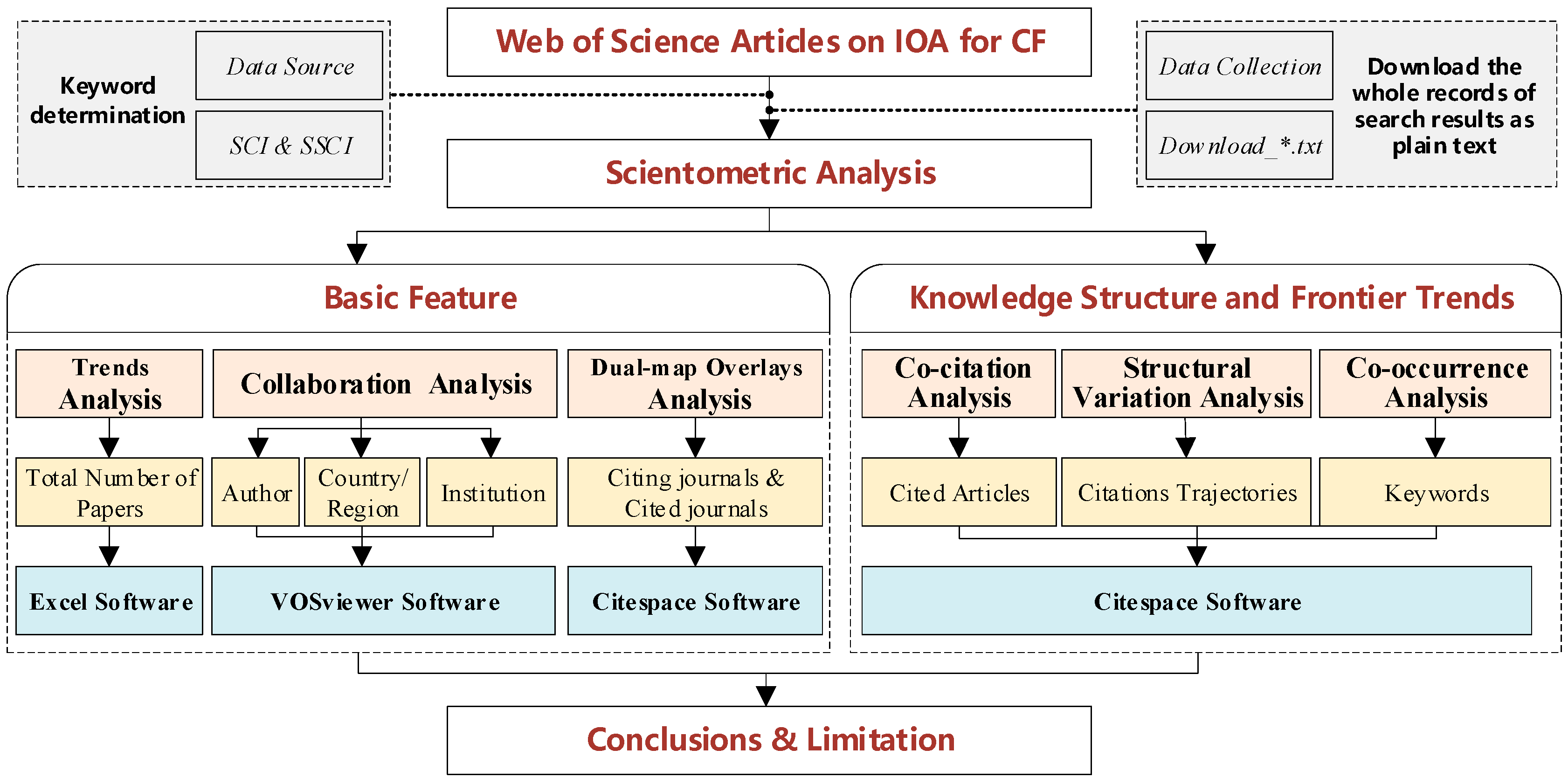


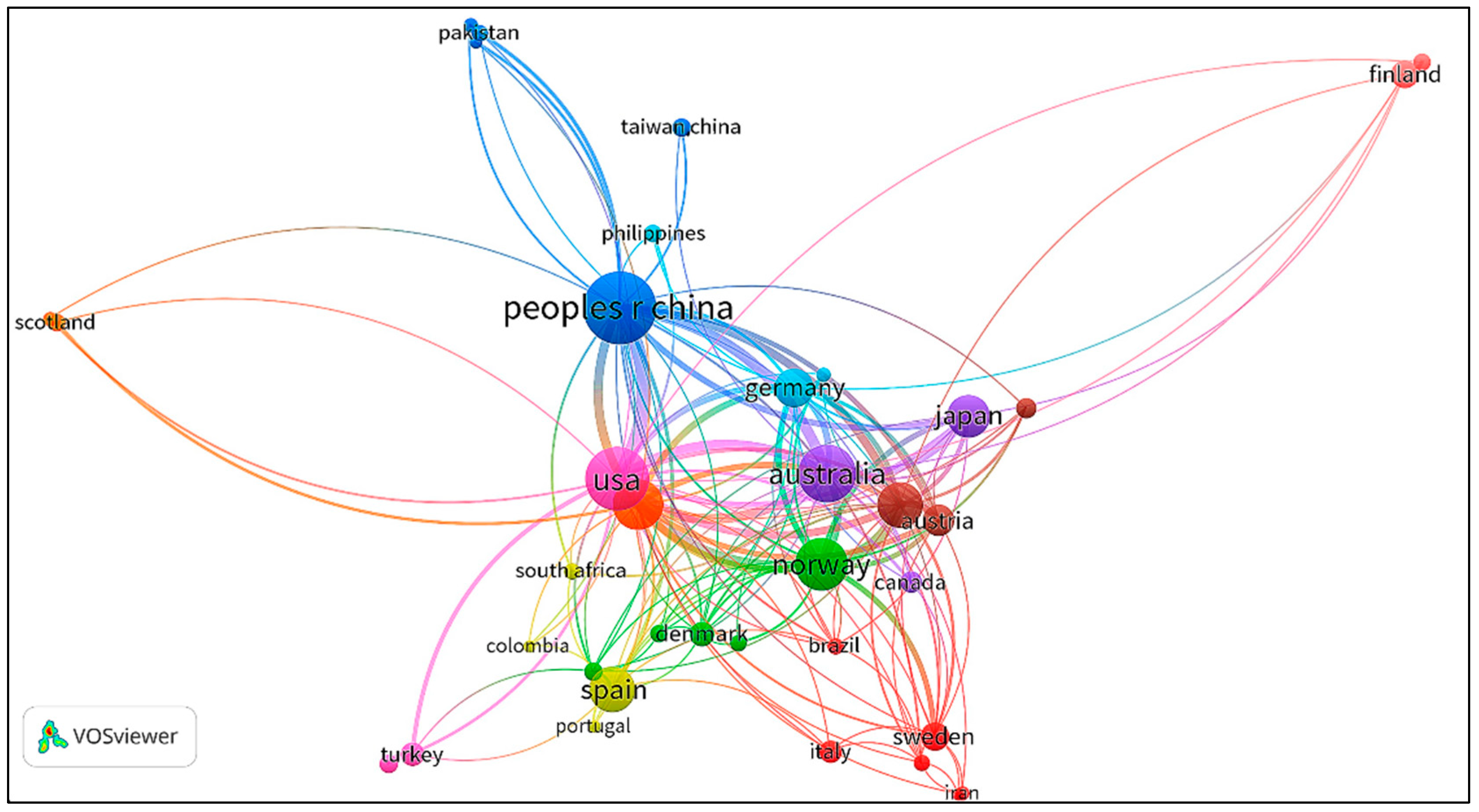

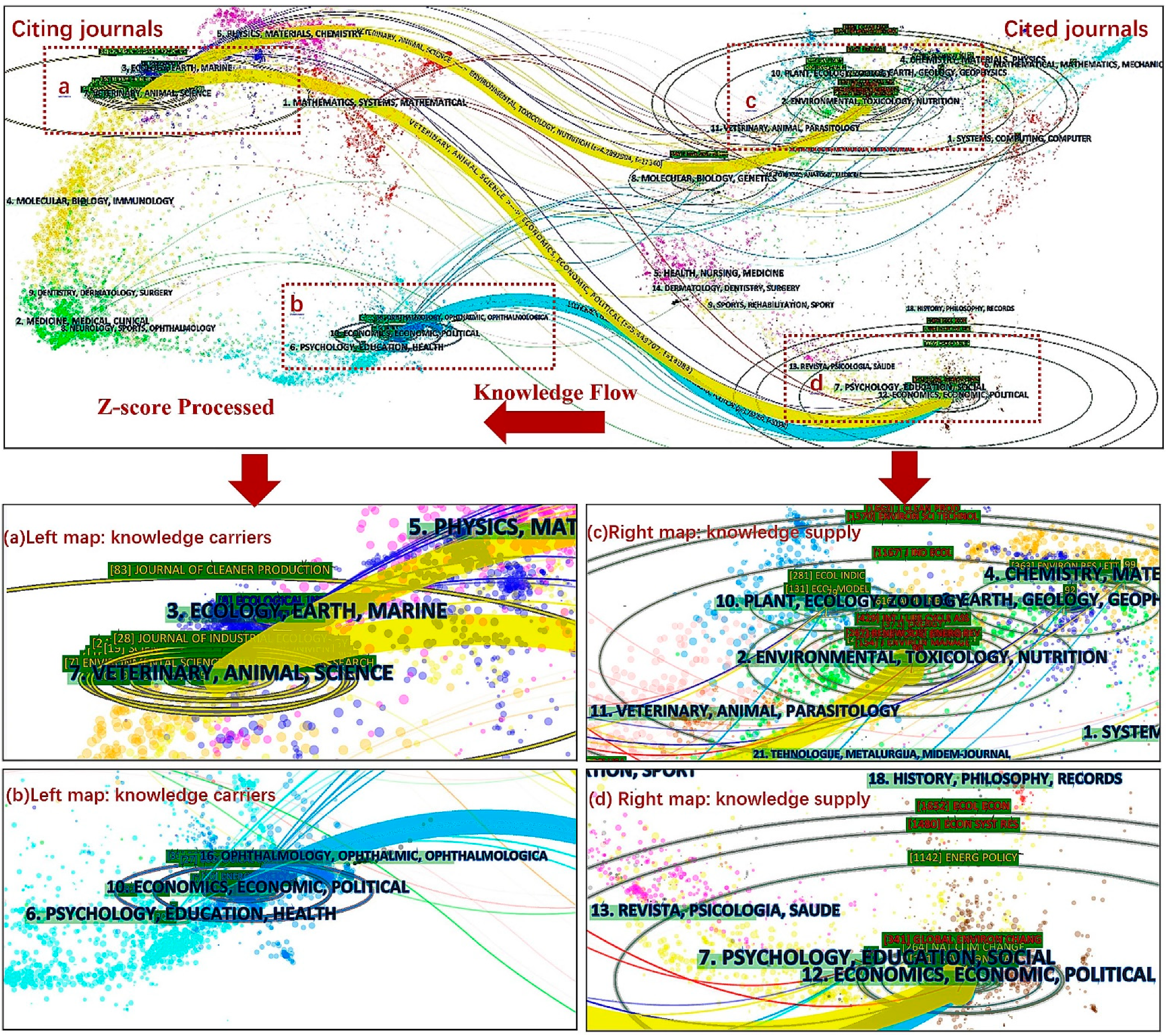
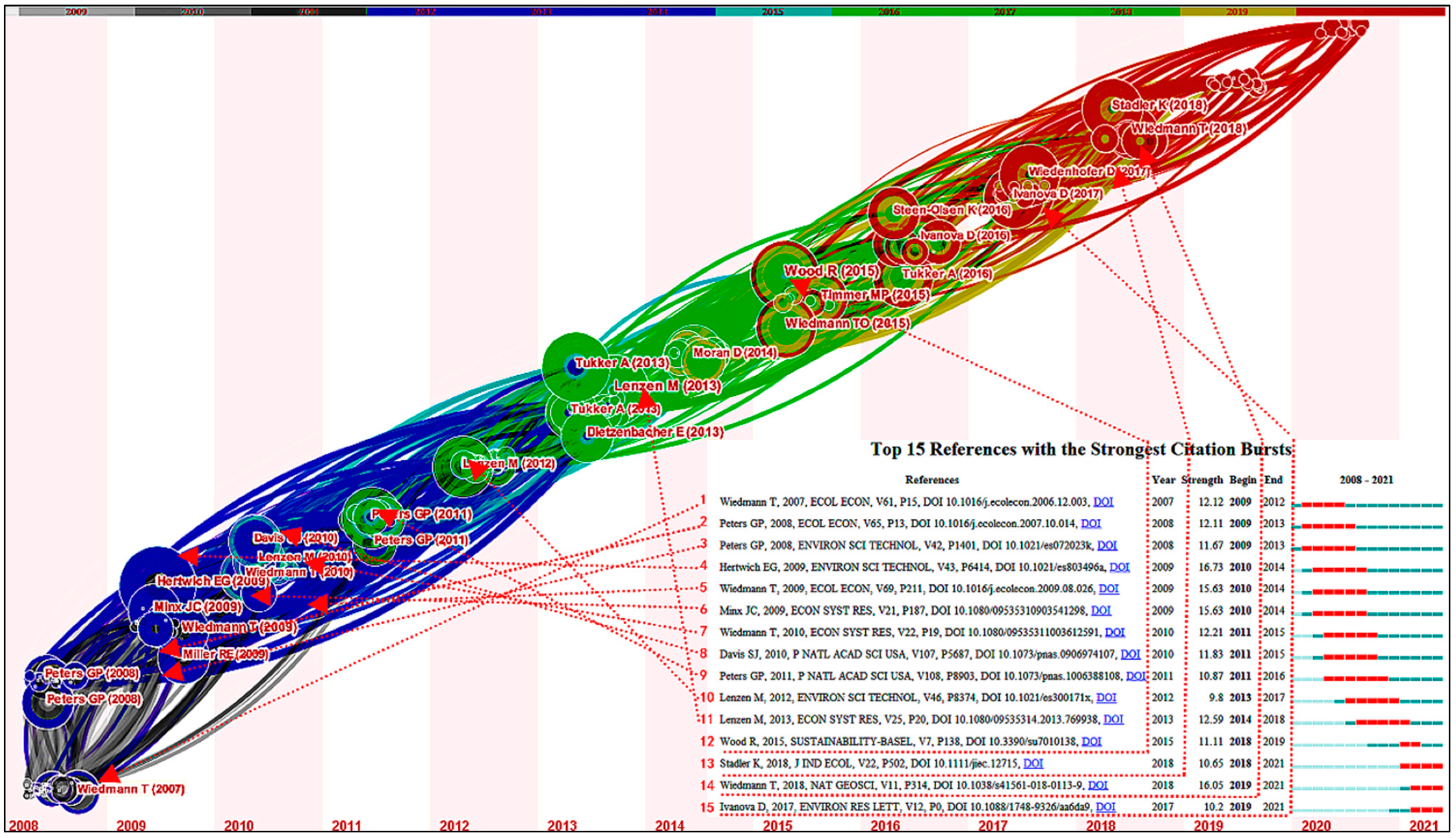
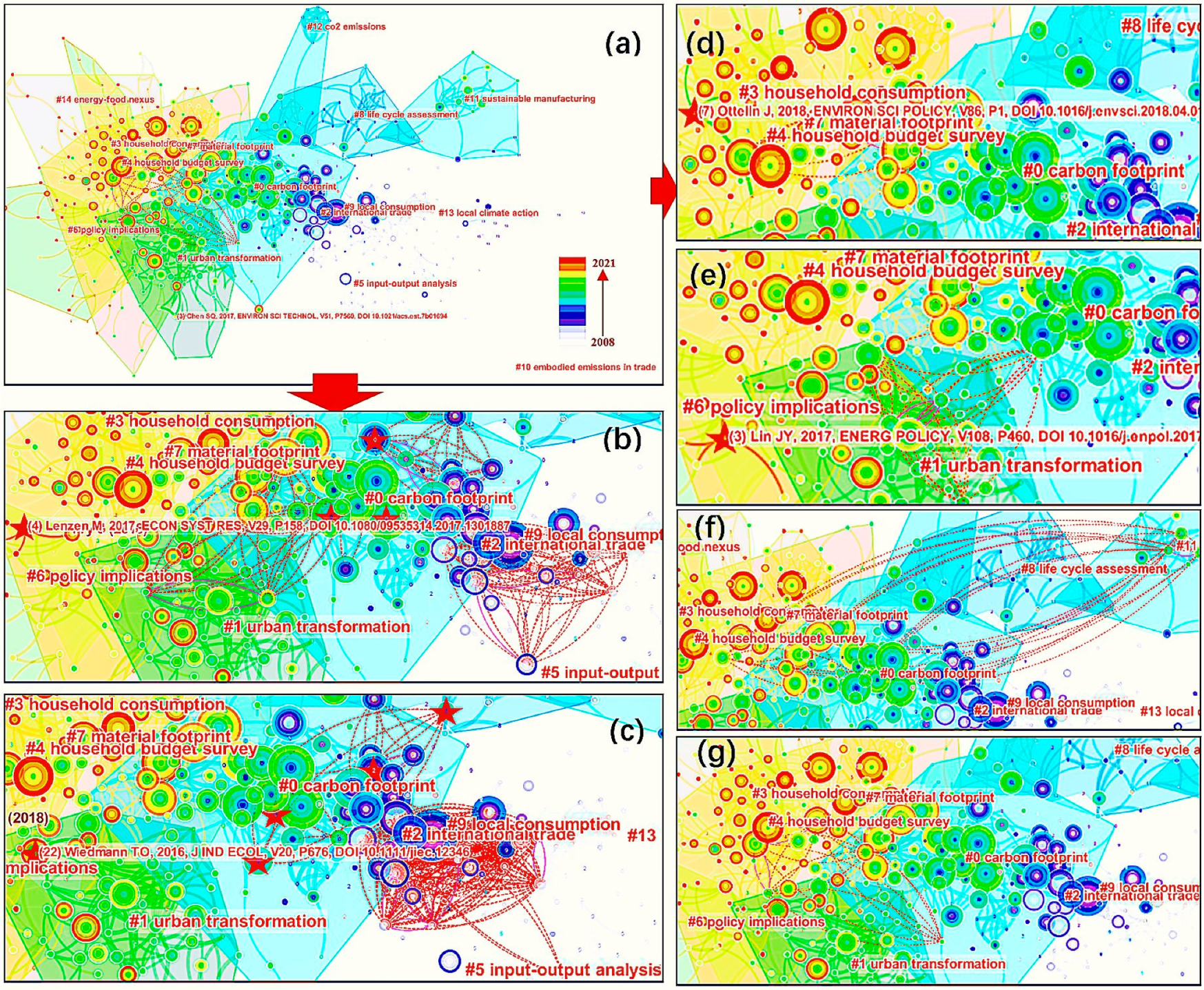
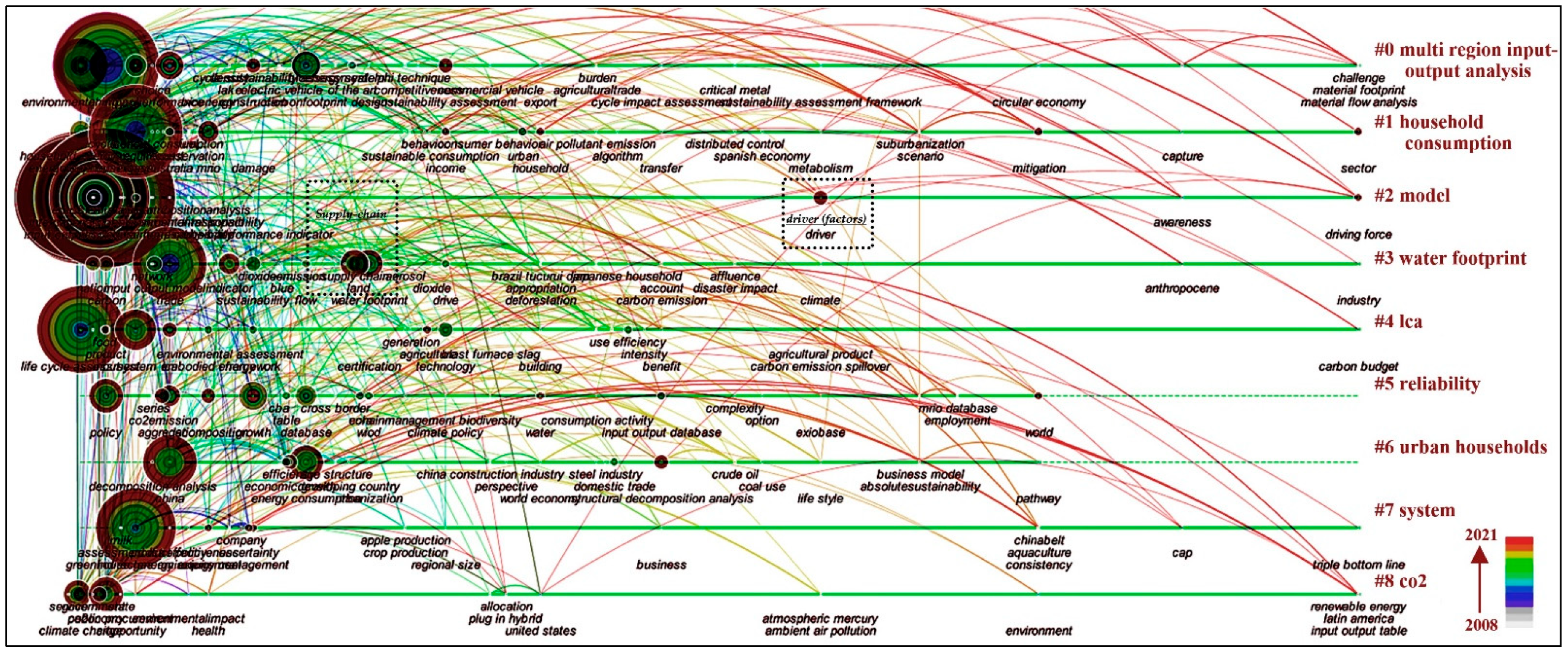
| Author | Frequency | Percentage | Author | Frequency | Percentage |
|---|---|---|---|---|---|
| Wood Richard | 36 | 7.3% | Moran Daniel | 16 | 3.3% |
| Lenzen Manfred | 29 | 5.9% | Tukker Arnold | 16 | 3.3% |
| Wiedmann Thomas | 26 | 5.3% | Onat Nuri Cihat | 12 | 2.4% |
| Hertwich Edgar G | 21 | 4.3% | Peters Glen | 12 | 2.4% |
| Kucukvar Murat | 19 | 3.9% | Tatari Omer | 12 | 2.4% |
| Country (Region) | Frequency | Percentage | Country (Region) | Frequency | Percentage |
|---|---|---|---|---|---|
| China | 142 | 28.9% | Netherlands | 50 | 10.2% |
| USA | 102 | 20.8% | Spain | 48 | 9.8% |
| Australia | 82 | 16.7% | Japan | 44 | 9.0% |
| Norway | 68 | 13.8% | Germany | 34 | 6.9% |
| England | 64 | 13.0% | Austria | 22 | 4.5% |
| Institution (First Author) | Frequency | Percentage |
|---|---|---|
| Norwegian University of Science and Technology | 56 | 11.4% |
| Leiden University | 54 | 11.0% |
| University of Sydney | 51 | 10.4% |
| Beijing Normal University | 28 | 5.7% |
| University of New South Wales Sydney | 28 | 5.7% |
| Chinese Academy of Sciences | 22 | 4.5% |
| University of Leeds | 21 | 4.3% |
| Tsinghua University | 17 | 3.5% |
| Universidad De Castilla La Mancha | 17 | 3.5% |
| Yale University | 17 | 3.5% |
| Title | Year | Author | Source | Freq | Centrality | Burst |
|---|---|---|---|---|---|---|
| Carbon footprint of nations: a global, trade-linked analysis | 2009 | Edgar G. Hertwich [48] | Environmental Science and Technology | 44 | 0.11 | 16.74 |
| Input–Output analysis and carbon footprinting: an overview of applications | 2009 | J.C. Minx [49] | Economic Systems Research | 38 | 0.06 | 15.64 |
| A review of recent multi-region input–output models used for consumption-based emission and resource accounting | 2009 | Thomas Wiedmann [50] | Ecological Economics | 38 | 0.02 | 15.64 |
| Growth in emission transfers via international trade from 1990 to 2008 | 2011 | Glen P. Peters [51] | Proceedings of the National Academy of Sciences of the United States of America | 39 | 0.02 | 16.08 |
| Building eora: a global multi-region input–output database at high country and sector resolution | 2013 | Manfred Lenzen [52] | Economic Systems Research | 49 | 0.05 | 12.53 |
| Global multiregional input–output frameworks: an introduction and outlook | 2013 | Arnold Tukker [53] | Economic Systems Research | 43 | 0.13 | 8.86 |
| The material footprint of nations | 2013 | Thomas Wiedmann [54] | Proceedings of the National Academy of Sciences of the United States of America | 40 | 0.07 | 9.09 |
| Global sustainability accounting—developing exiobase for multi-regional footprint analysis | 2015 | Richard Wood [55] | Economic Systems Research | 49 | 0.07 | 11.09 |
| Environmental and social footprints of international trade | 2018 | Thomas Wiedmann [56] | Nature Geoscience | 39 | 0.09 | 10.89 |
| Exiobase 3: developing a time series of detailed environmentally extended multi-regional input-output tables | 2018 | Konstantin Stadler [57] | Journal of Industrial Ecology | 36 | 0.01 | 10.64 |
| Keyword | Freq | Centrality | Year | Keyword | Freq | Centrality | Year |
|---|---|---|---|---|---|---|---|
| carbon footprint | 159 | 0.04 | 2009 | trade | 59 | 0.03 | 2011 |
| consumption | 148 | 0.01 | 2009 | model | 54 | 0.06 | 2009 |
| input–output analysis | 130 | 0.02 | 2008 | environmental impact | 53 | 0.09 | 2008 |
| international trade | 99 | 0.07 | 2008 | China | 43 | 0.05 | 2011 |
| emission | 86 | 0.07 | 2008 | footprint | 40 | 0.1 | 2009 |
| impact | 82 | 0.13 | 2010 | system | 37 | 0.07 | 2010 |
| CO2 emission | 80 | 0.11 | 2009 | input output | 32 | 0.1 | 2009 |
| greenhouse gas emission | 77 | 0.09 | 2010 | city | 30 | 0.14 | 2009 |
| energy | 76 | 0.11 | 2009 | energy consumption | 25 | 0.04 | 2014 |
| Life-cycle assessment | 66 | 0.05 | 2008 | climate change | 25 | 0.13 | 2008 |
Publisher’s Note: MDPI stays neutral with regard to jurisdictional claims in published maps and institutional affiliations. |
© 2022 by the authors. Licensee MDPI, Basel, Switzerland. This article is an open access article distributed under the terms and conditions of the Creative Commons Attribution (CC BY) license (https://creativecommons.org/licenses/by/4.0/).
Share and Cite
Han, J.; Tan, Z.; Chen, M.; Zhao, L.; Yang, L.; Chen, S. Carbon Footprint Research Based on Input–Output Model—A Global Scientometric Visualization Analysis. Int. J. Environ. Res. Public Health 2022, 19, 11343. https://doi.org/10.3390/ijerph191811343
Han J, Tan Z, Chen M, Zhao L, Yang L, Chen S. Carbon Footprint Research Based on Input–Output Model—A Global Scientometric Visualization Analysis. International Journal of Environmental Research and Public Health. 2022; 19(18):11343. https://doi.org/10.3390/ijerph191811343
Chicago/Turabian StyleHan, Jingwei, Zhixiong Tan, Maozhi Chen, Liang Zhao, Ling Yang, and Siying Chen. 2022. "Carbon Footprint Research Based on Input–Output Model—A Global Scientometric Visualization Analysis" International Journal of Environmental Research and Public Health 19, no. 18: 11343. https://doi.org/10.3390/ijerph191811343
APA StyleHan, J., Tan, Z., Chen, M., Zhao, L., Yang, L., & Chen, S. (2022). Carbon Footprint Research Based on Input–Output Model—A Global Scientometric Visualization Analysis. International Journal of Environmental Research and Public Health, 19(18), 11343. https://doi.org/10.3390/ijerph191811343







